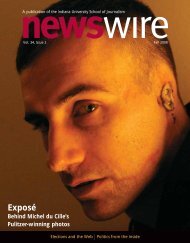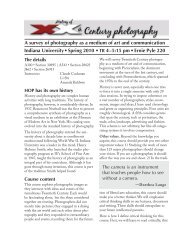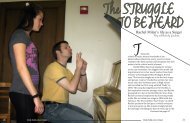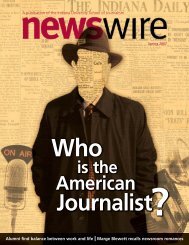The changing face of photojournalism - Indiana University School of ...
The changing face of photojournalism - Indiana University School of ...
The changing face of photojournalism - Indiana University School of ...
- No tags were found...
Create successful ePaper yourself
Turn your PDF publications into a flip-book with our unique Google optimized e-Paper software.
after serving in the ROTC in Fort Knox, Ky., he took a jobwith the Associated Press in <strong>Indiana</strong>polis, and he never left.As night wire editor, he was on call to cover breakingnews during the night. He reported several major breakingnews stories, including the crash <strong>of</strong> a Northwest Airlinespassenger plane that slammed into the ground near TellCity, Ind., in March 1960, killing 63 people; the explosion<strong>of</strong> a propane tank at the <strong>Indiana</strong> State Fair’s Coliseum duringa Holiday on Ice show in October 1963, which resultedin the deaths <strong>of</strong> 74 people; a December 1964 nursing homefire in Fountaintown, Ind., in which 20 residents died; andthe mid-air collision in September 1969 <strong>of</strong> a Piper Cherokeeand an Allegheny Airlines DC-9 over Shelby County,which killed 83 people.Despite the horrors he witnessed, Anderson says thetraining he received at IU enabled him to keep hisemotions in check.“Because <strong>of</strong> the training, the byword was to be cool,” hesays. “Tell the story. Don’t get involved. I never had deepfeelings about these things because I was so detached.”But a murder-suicide did bring him down, not throughhis own coverage, but through that <strong>of</strong> New York-based APwriter and Pulitzer Prize-winner Saul Pett, who came to <strong>Indiana</strong>to follow up on the crime. Pett’s in-depth writing on theincident affected Anderson deeply. He can’t remember all thedetails <strong>of</strong> the crime, but he remembers what Pett wrote.“What touched me about his story was his description <strong>of</strong>the scene in a woods where the perp committed suicide,”Anderson says. “Mr. Pett discovered the accused was sitting onthe ground, his back against a tree. It was obvious in lookingat the scene, Mr. Pett wrote, that the accused sat for a considerabletime, apparently contemplating what he’d done, beforefinally ending his own life. For me, his article was an emotionpackedpiece on a life that stumbled into desperation.”<strong>The</strong>re were fun times, too. Anderson sat way up in thebleachers to cover the Beatles’ performance at the Coliseum —an assignment he tried to get out <strong>of</strong>.“I wasn’t a Beatles fan, although I have come to appreciatetheir music,” he says. “I never heard one note from the Beatles,there was so much screaming from the girls.”“My whole intent was to providea way for young people who didnot have the financial meansto get to college.”Marty Anderson with his late wife, Ann.<strong>The</strong> overnight wire crewEarleen Fisher, BA’68, joined the AP in <strong>Indiana</strong>polis during hersenior year at IU. After graduation, she worked in the bureaufull time for three years before moving on to AP bureaus inNew York, Cairo and New Delhi.Anderson, she says, was one <strong>of</strong> a select group <strong>of</strong> editors —mostly men — around the country who made a career out <strong>of</strong>the overnight wire job. In addition to covering news that brokeduring the night, he went on assignment every year to the<strong>Indiana</strong> State Fair, which he loved, looking for features about4-H champions and other fair staples.Fisher remembers Anderson’s fastidious habits on the nightdesk in the small AP <strong>of</strong>fice in the <strong>Indiana</strong>polis Star and <strong>Indiana</strong>polisNews building. Although he worked virtually alone inthe <strong>of</strong>fice for much <strong>of</strong> the night, she says, Anderson wouldcome to work in a sports jacket, shirt and tie.“He was a big man,” she says. “He sort <strong>of</strong> filled up theroom, although that wasn’t hard to do, considering the size <strong>of</strong>the room we had.”After he arrived, he would come in and straighten up hisdesk, arranging everything just so.“That was the superficial dressing on an organized, efficientman, dedicated to his job,” Fisher says, recounting that one <strong>of</strong>fall 2010 / newswire < 17 >
















